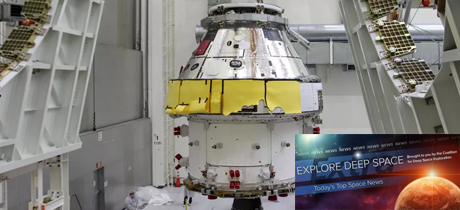New Episode of The Deep Space Podcast Available Now
Tune in to the second episode of our Deep Space Podcast’s Workforce of the Future series. Young professionals Beverly Case of Jacobs Space Operations Group and David Vaughn of Northrop Grumman share insights into their careers and what it has taken for them to thrive in aerospace. David and Beverly provide details about the Space Launch System (SLS) rocket booster production at the Northrop Grumman facilities in Utah and stacking at NASA’s Kennedy Space Center (KSC), as well as the wide range of activities of NASA’s Exploration Ground Systems (EGS). Click here to listen now.
In Today’s Deep Space Extra… NASA, Lockheed Martin addressing Artemis I Orion concern. NASA weighing options for future planetary radar capabilities after Arecibo.
Human Space Exploration
Component failure in NASA’s deep-space crew capsule could take months to fix
Coalition Member in the News – Lockheed Martin
The Verge (11/30): Engineers are working to resolve an issue with a redundant channel in a power and data unit (PDU) on the Artemis I Orion crew module adapter. The team is continuing with other closeout activities while troubleshooting the issue. “We are fully committed to seeing Orion launch next year on its historic Artemis I mission to the Moon,” a representative for Lockheed Martin told The Verge.
Space Science
China likely to attempt its Chang’e 5 Moon landing on Tuesday
Ars Technica (11/30): Launched November 23 on its closely watched lunar sample return mission, China’s Chang’e 5 could attempt its descent from lunar orbit to the surface of the Moon at the Ocean of Storms Tuesday morning, according to efforts by Ars Technica to sort out the timeline. The spacecraft’s return vehicle is targeted to come back to Earth with sample material in mid-December.
NASA weighing options for future planetary radar capabilities after Arecibo
SpaceNews.com (12/1): With the Arecibo radio telescope set to be decommissioned, NASA is beginning to consider options for future planetary radar capabilities, including potential cooperation with the U.S. Space Force. NASA has used the radio telescope at Arecibo Observatory in Puerto Rico for years, particularly for studies of near-Earth asteroids.
The case for Apophis
The Space Review (11/30): The asteroid Apophis offers an exploration opportunity as it sweeps by the Earth on April 13, 2029. Apophis is several hundred meters across, making it prime for study with ground-based observatories and small spacecraft launched from Earth. A potential mission could have scientific value as well as inform efforts to prevent future asteroid impact threats. One option might be to extend NASA’s OSIRIS-REx asteroid sample return mission, which is due back at Earth in September 2023, in order to survey Apophis.
Other News
China pushes ahead with super-heavy-lift Long March 9
SpaceNews.com (11/30): China is moving forward with the Long March 9 super heavy launch vehicle for crewed and robotic deep space exploration. The massive rocket is in the research and development stage with a test launch planned for around 2030, according to the China National Space Administration secretary-general, Xu Hongliang.
FCC Chairman Ajit Pai to leave agency in January
SpaceNews.com (11/30): FCC Chairman Ajit Pai has announced plans to depart the post on January 20, 2021. Over his four years as chair, Pai helped to streamline satellite licensing regulations and open the C band spectrum for 5G cellular network operators. Permission was also granted to Ligado Networks for a low power broadband network, an action opposed by commercial satellite operators, the Pentagon, and the Commerce Department out of concerns it would disrupt GPS signals.

